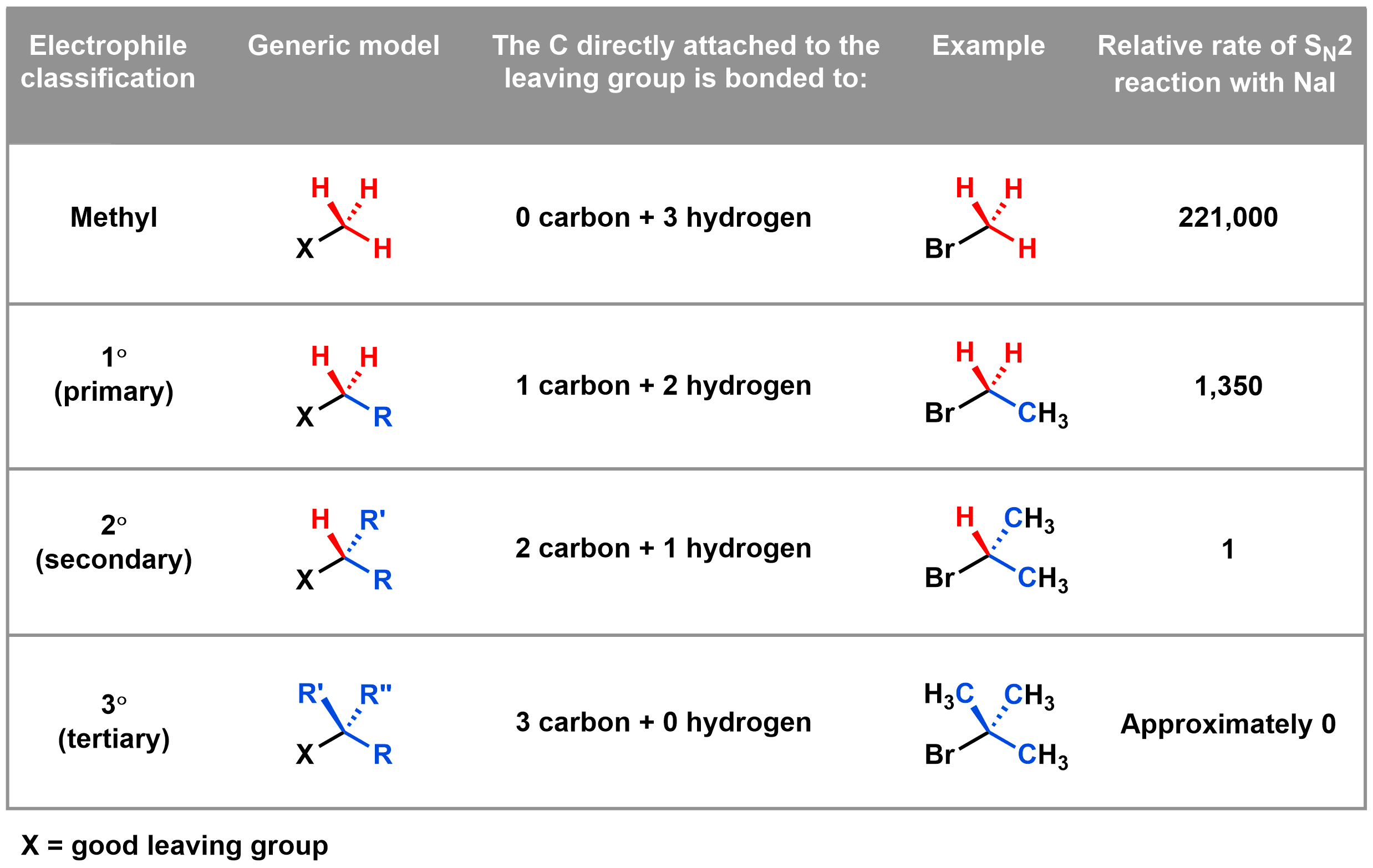In an SN2 reaction:
- Electrophiles with fewer branches close to the reactive carbon react more quickly.
- Negatively charged nucleophiles react more quickly than neutral nucleophiles.
- Within the same row of the periodic table, nucleophiles with less electronegative nucleophilic atoms tend to react more quickly.
- Sterically bulky nucleophiles tend to react less quickly.
- Groups that leave as weaker bases generally make better leaving groups.
Subtle changes in the reaction components of an SN2 process can profoundly impact the reaction rate. In this course, we will focus on how the (1) electrophile, (2) nucleophile, and (3) leaving group affect the rates of SN2 reactions.
1) Electrophile:
As was discussed in Section 1.2, the nucleophile in an SN2 reaction approaches the electrophile from the side opposite to the leaving group ("backside attack"). This means that the three other groups attached to the reactive carbon in the electrophile face towards the nucleophile as it approaches.
If these groups are all sterically bulky (e.g., all CH3 groups), then the nucleophile will have a significant steric interaction when it gets close to the electrophilic centre. This results in slow reaction rates. However, if these three groups are small (e.g. all H's), then the electrophilic carbon is sterically accessible and the reactions will proceed more quickly. As a general trend for SN2 reactions, the smaller the groups attached to the electrophilic centre, the faster the reaction proceeds.
Try rotating the space-filling models of bromomethane and 2-bromo-2-methylpropane below to see how much more accessible the reactive carbon (shown in grey, directly attached to the red bromine) is via backside attack in bromomethane compared to 2-bromo-2-methylpropane.
| bromomethane | 2-bromo-2-methylpropane |
We can classify electrophiles using the table below to help predict whether they will work well in an SN2 reaction.

The last column in the above table gives us an idea of the relative rate of an SN2 reaction when using each of these nucleophiles. In a substitution reaction between the example electrophile (4th column) and NaI, the SN2 mechanism is 221,000 times faster with a methyl electrophile and 1,350 times faster with a 1° electrophile compared to a 2° electrophile. An SN2 reaction with a 3° electrophile does not proceed to an appreciable degree.
2) Nucleophile:
By definition, nucleophiles donate pairs of electrons. The more nucleophilic the atom, the faster it donates its lone pair (i.e. reacts) in a substitution reaction. How “good” a nucleophile is (i.e. how quickly it reacts) depends on its charge, electronegativity, polarizability, and steric hindrance. The general trends presented below may sometimes differ, or even reverse, under different reaction conditions (e.g. using a different reaction medium), but this will not be covered until future organic chemistry courses.
- Charge: When comparing two species with the same nucleophilic atom, the more negatively charged the nucleophilic atom is, the faster it will donate its pair of electrons. Thus, negatively charged nucleophiles tend to be good, and neutral nucleophiles tend to be poor. In the examples below, the nucleophilic atoms are all oxygen. The species with a negative formal charge on the oxygen will react more rapidly in an SN2 reaction.

- Electronegativity: When comparing the nucleophilicity of two molecules where the atoms donating the electrons are in the same row of the periodic table, compare their relative electronegativities. Less electronegative atoms hold onto their electrons less tightly, which makes these electrons more readily available for donation. As a consequence, the nucleophile with the less electronegative nucleophilic atom will react more quickly in an SN2 reaction. In the example below, the nucleophilic atoms are oxygen and nitrogen. Nitrogen is less electronegative and, therefore, its lone pair is not held as tightly and can more readily be donated faster in an SN2 reaction.

- Polarizability: Nucleophilicity is dependent on polarizability, but the relationship is heavily dependent on the reaction medium (solvent). It will not be covered in this course.
- Steric hindrance: In an SN2 reaction, the more substituents near the nucleophilic centre result in increased steric hindrance during backside attack. As a general trend, the more substitution adjacent to the nucleophilic centre, the slower the rate of an SN2 reaction. In the example below, the smallest nucleophile (A) reacts the fastest as it minimizes steric interaction. The closer the substitution to the nucleophilic centre (i.e. C vs D), the slower the reaction rate. Of the nucleophiles below, E reacts the slowest as it has three substituents adjacent to the nucleophilic oxygen.

3) Leaving group:
During the course of an SN2 reaction, both electrons from the bond that breaks transfer to the leaving group. As the SN2 reaction proceeds and the transition state forms, the leaving group starts to develop a negative charge. Generally, the better the leaving group can stabilize this charge, the faster the reaction will proceed. You can use the exact same factors we used to assess the strength of a base (e.g. electronegativity, polarizability, resonance, and induction) to assess leaving group ability. For example, in the diagram below, iodide is the most stable anion, and will therefore react most rapidly as a leaving group in SN2 reactions. As shown below, better leaving groups tend to be weaker bases. If you come across leaving groups that do not follow this trend, it is likely that the reaction medium (solvent) is affecting this relationship (beyond the scope of CHEM 123).

Neutral molecules such as H2O and NH3 make particularly good leaving groups.
Guided:
Note: the interactive components of this tutorial require html5 video, which is not supported by some mobile devices (e.g. iPhones). This tutorial is best viewed on a computer.
Interactive: